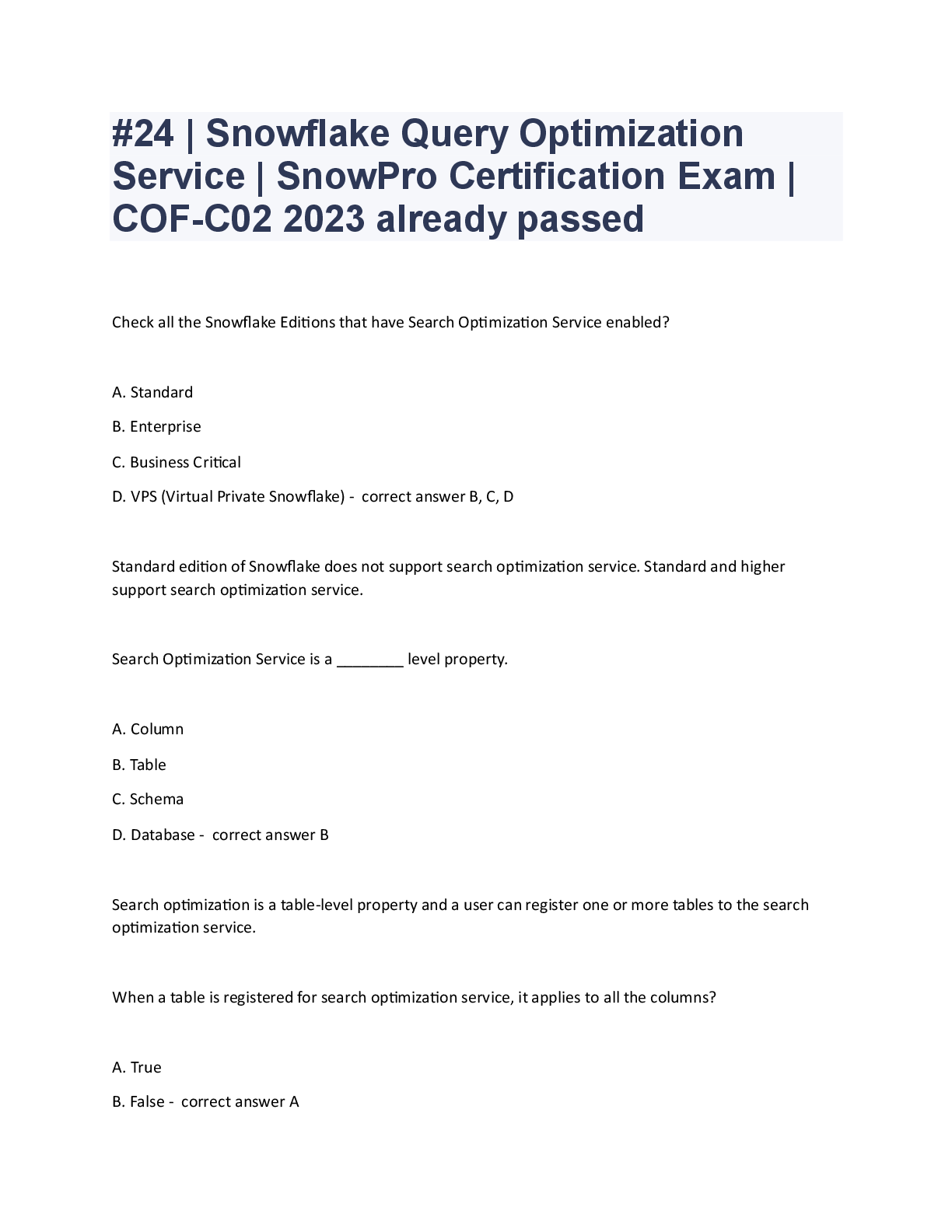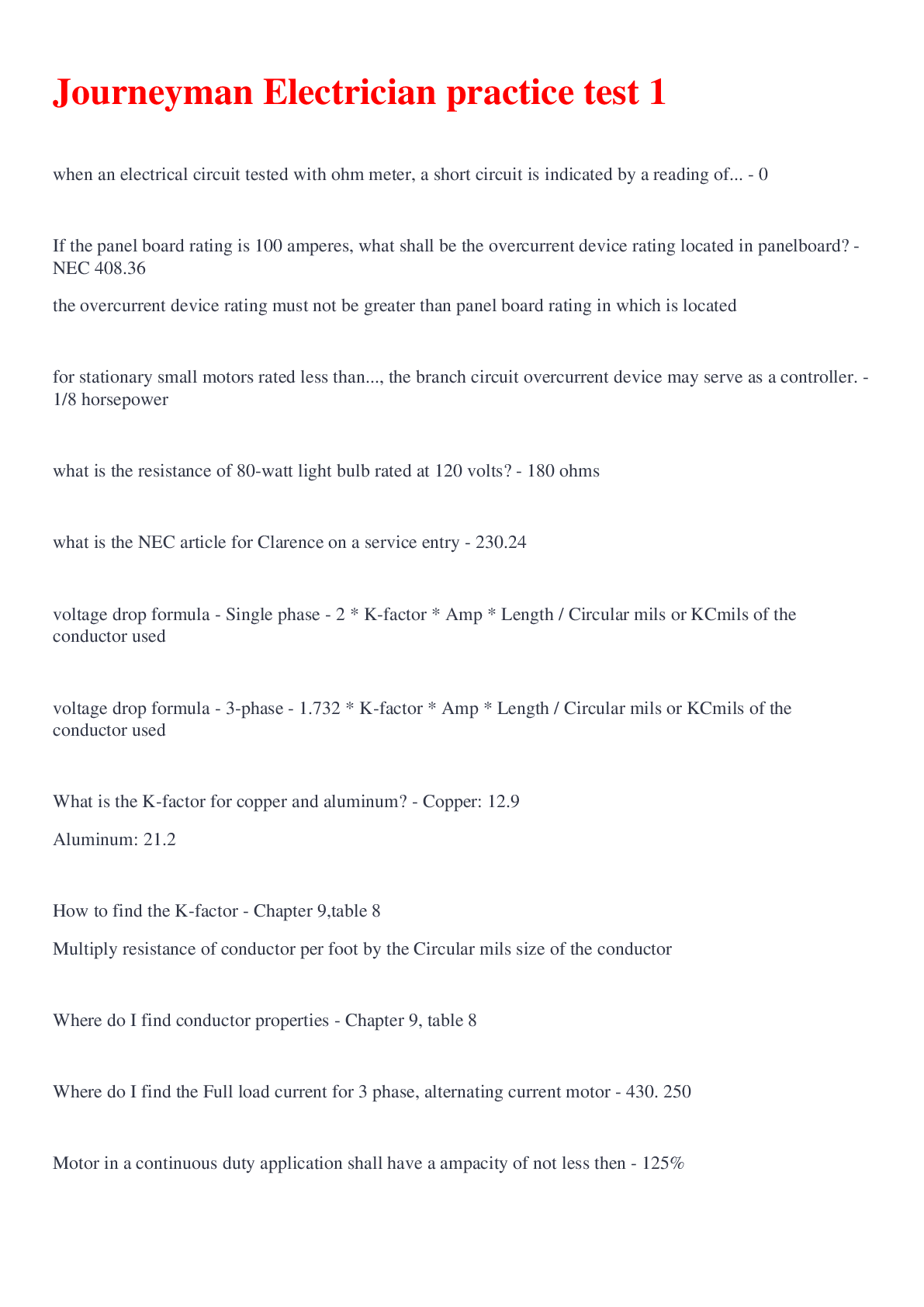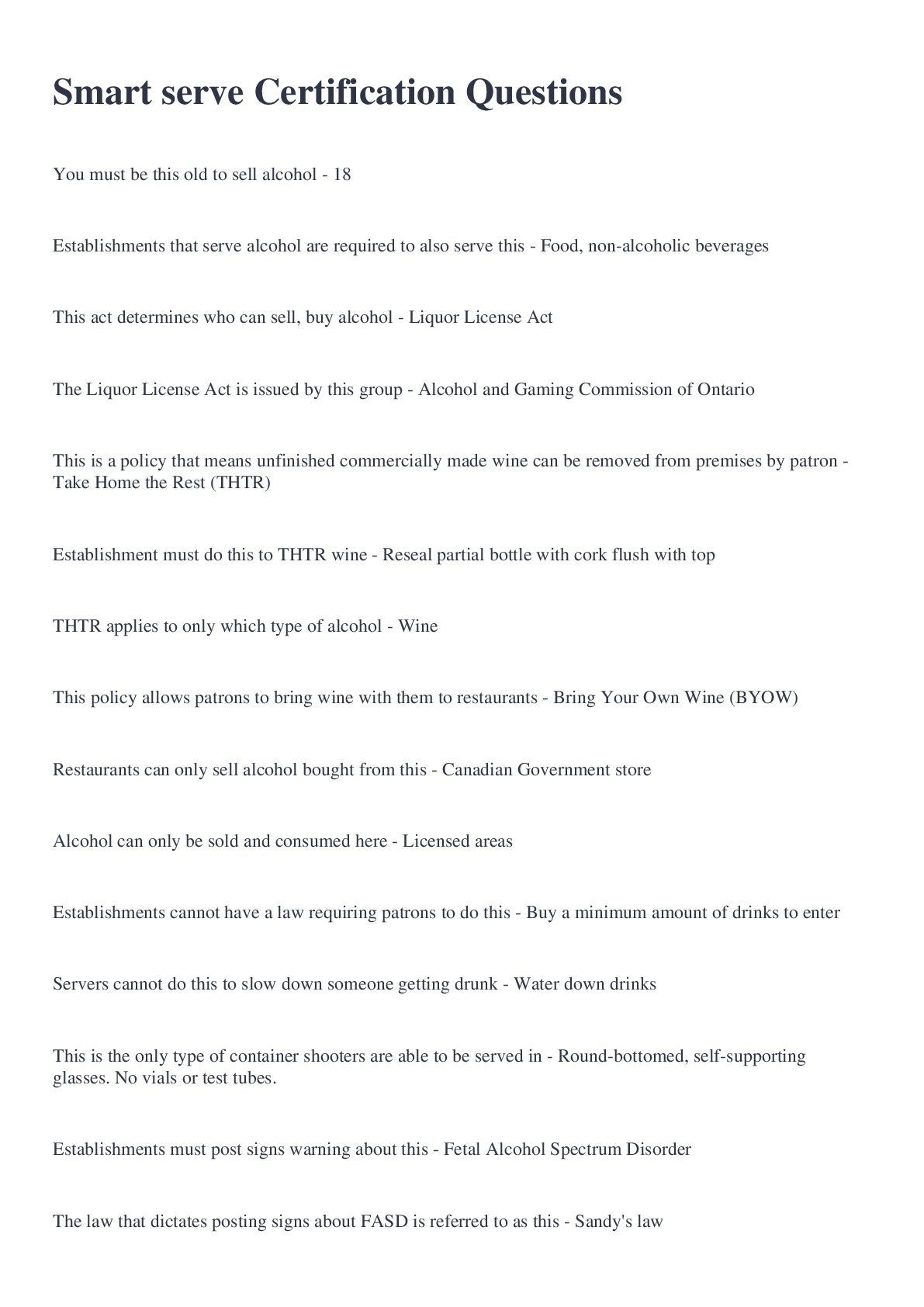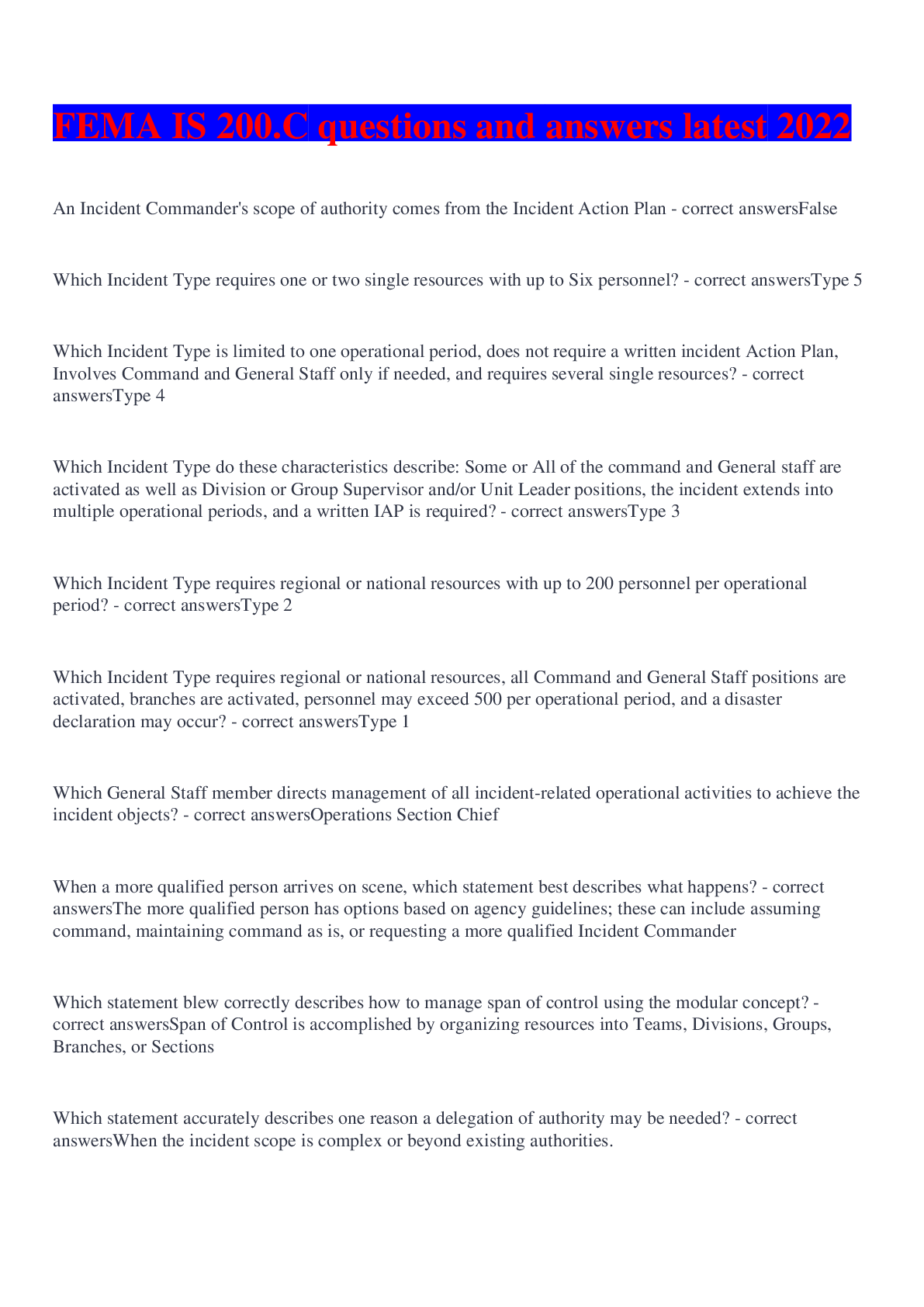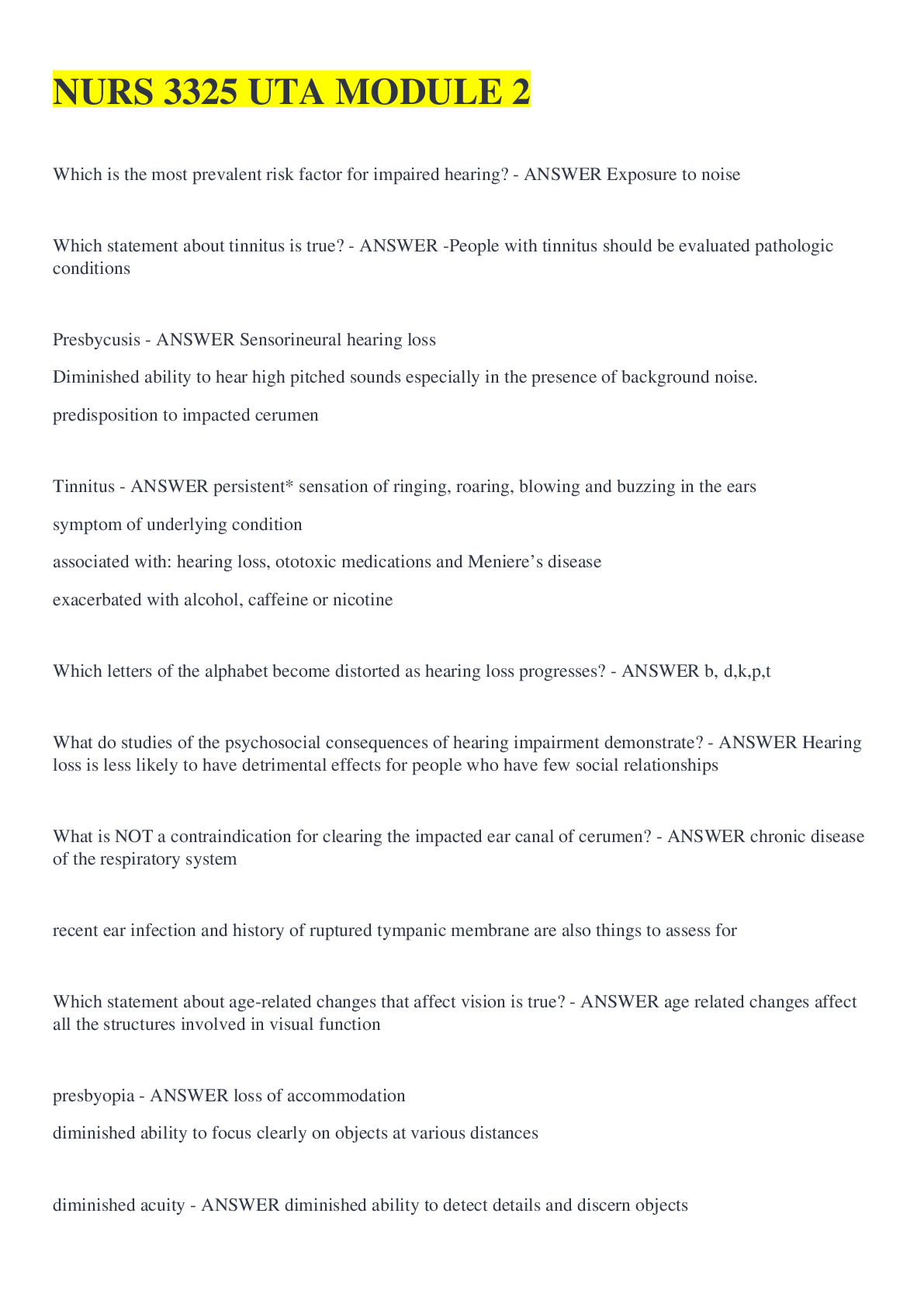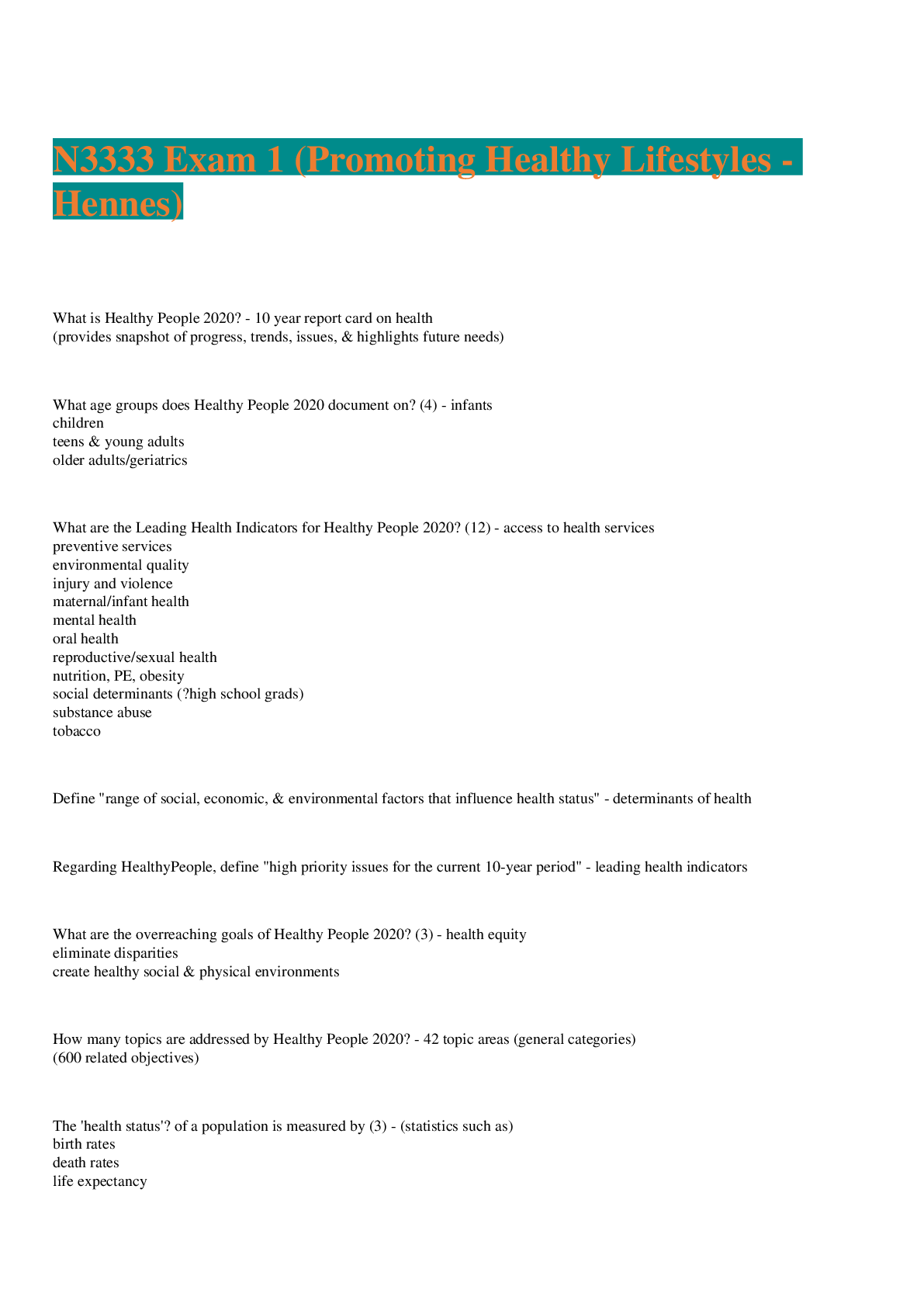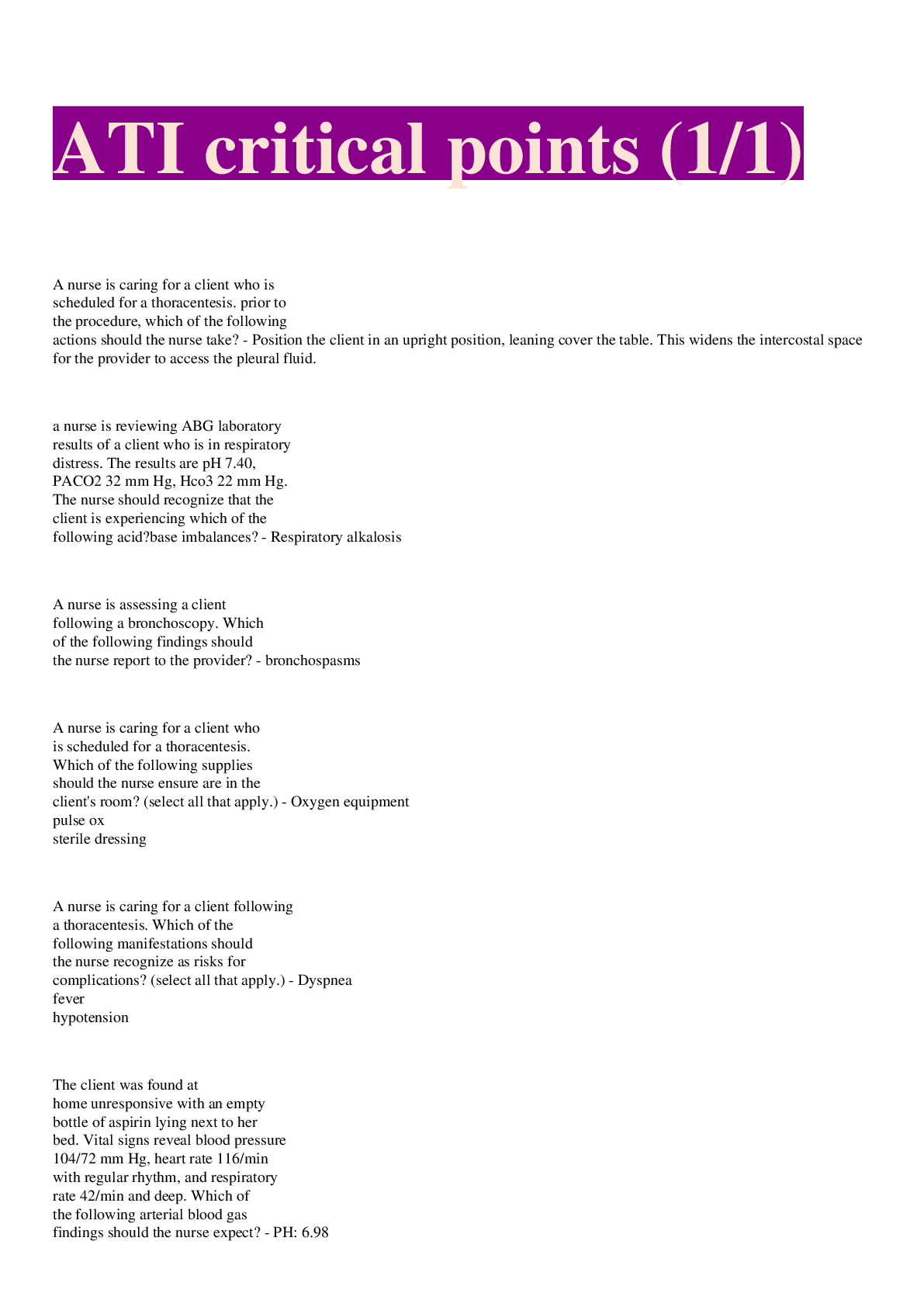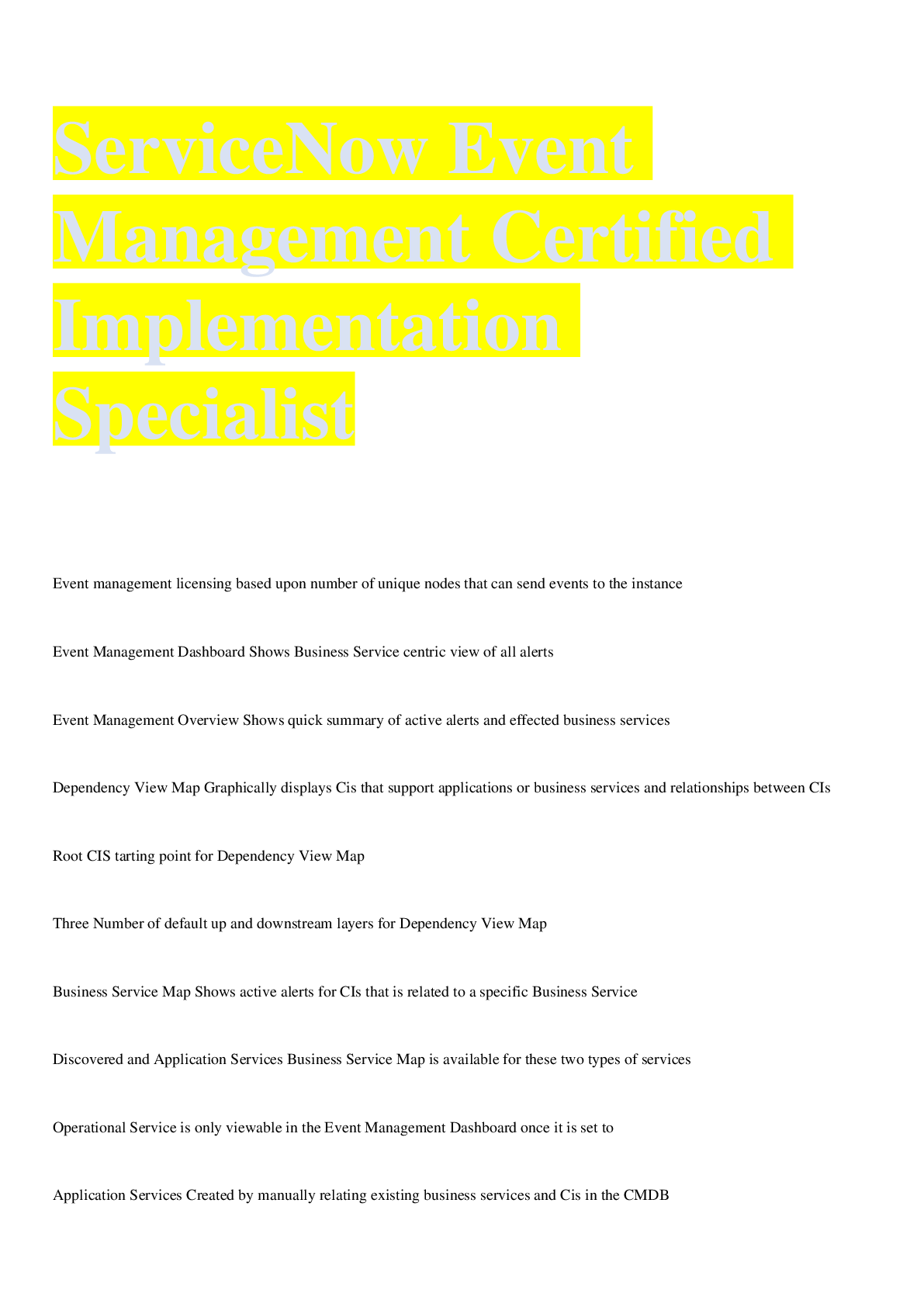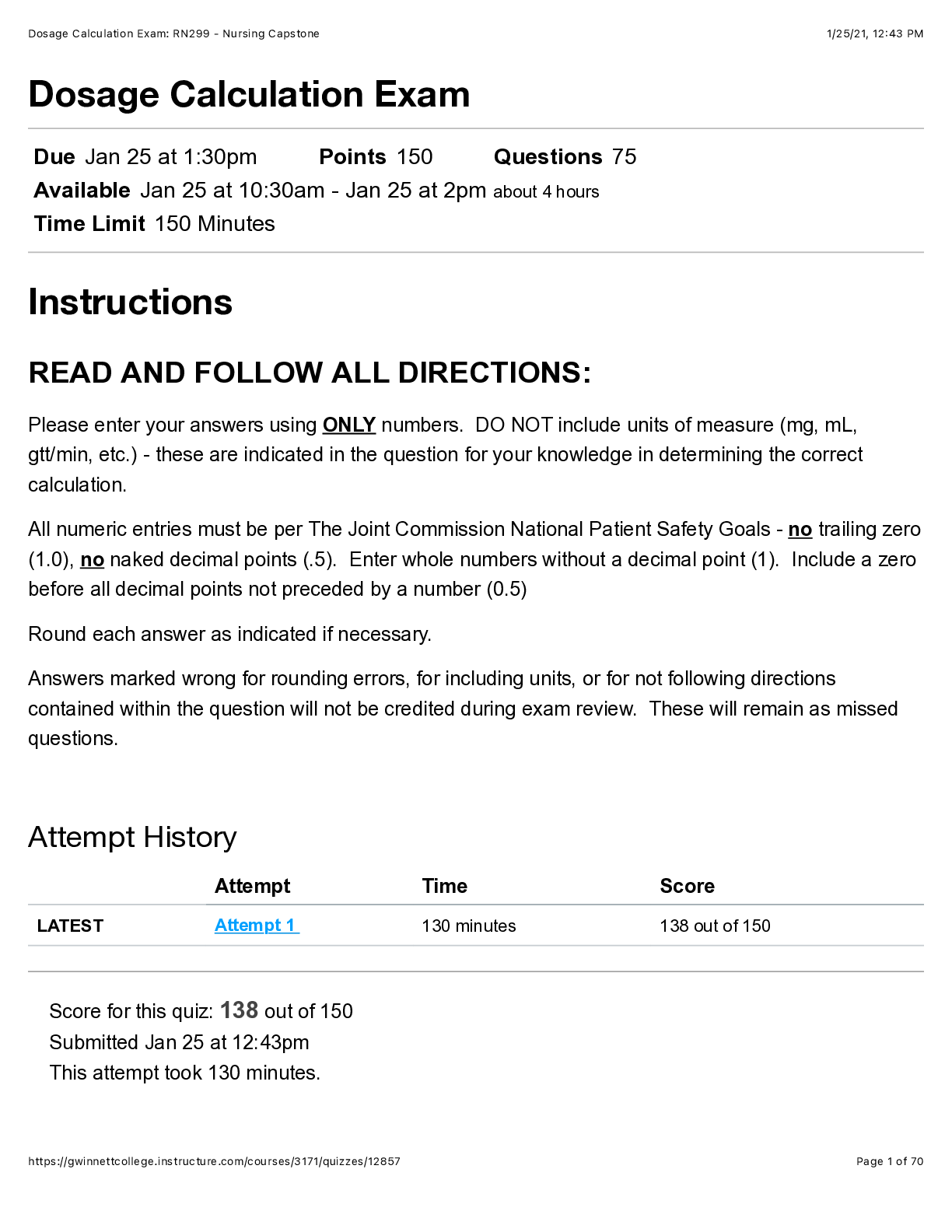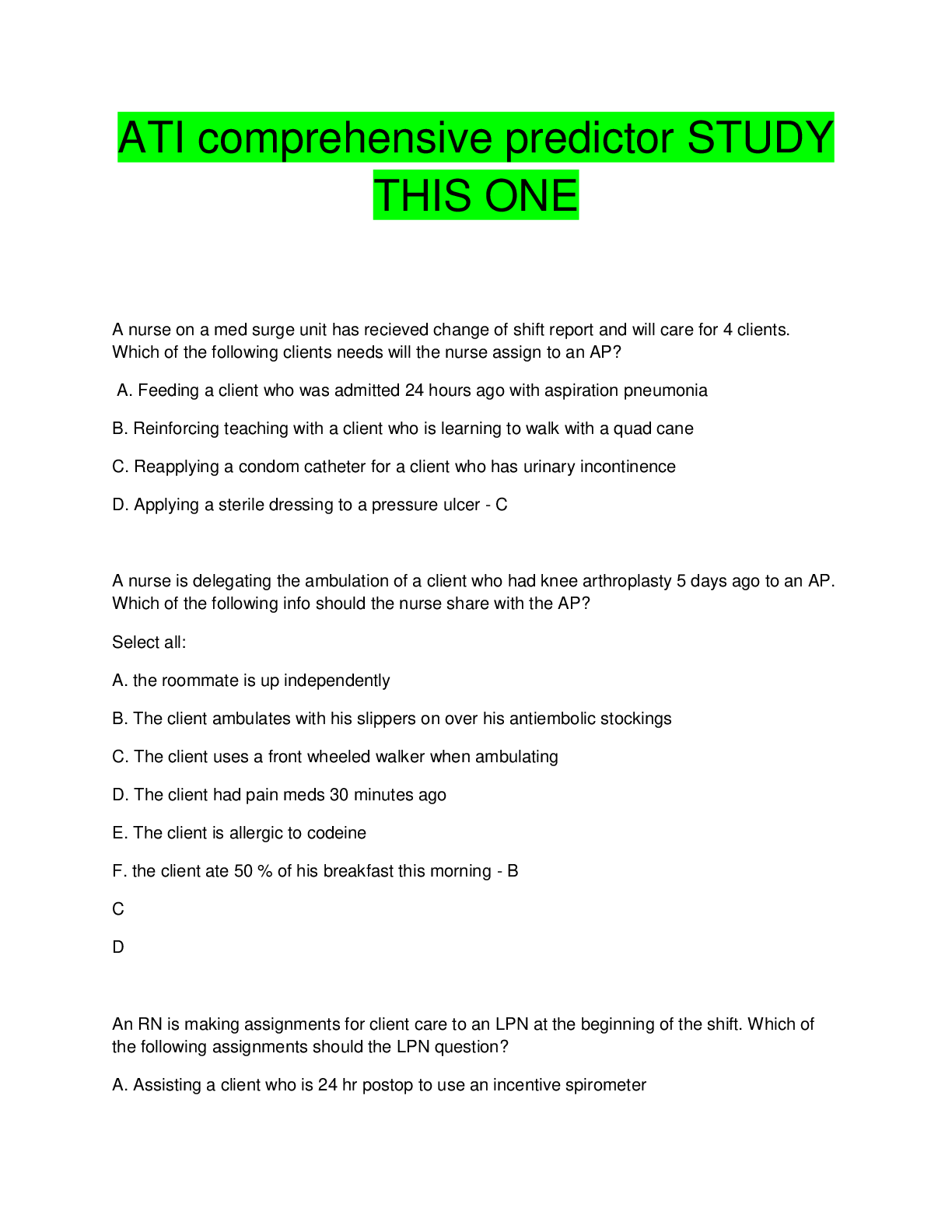NRNP Finals 6560 questions and answers 100%correct
Document Content and Description Below
coup-contrecoup injury Dual impacting of the brain into the skull; coup injury occurs at the point of impact; contrecoup injury occurs on the opposite side of impact, as the brain rebounds. Scal... p laceration: what, effect, management Primary head injury profuse bleeding - signs of hypovolemia Apply direct pressure Suture/ staple laceration Lidocaine 1% with epi to control bleeding, not close to nose/ ears Skull fracture: types, effect, management Primary head injury Simple: no displacement of bone. Observe and protect spine Depressed: bone fragment depressing thickness of scull Surgery for debridement. Give tetanus and seizure precautions Basilar: fracture at floor of skull Raccoon eye - periorbital bruising battle's sign: mastoid bruising otorrhea/ rhinorrhea - halo sign: do not obstruct flow Give Ab's Oral intubation and oral gastric instead of nasal Brain injury: types, effect, management Primary head injury Concussion: reversible change in brain functioning loss of consciousness, amnesia Do not give opioids, admit for unconsciousness greater than 2min Contusion: bruising to surface of brain with edema Frontal and temporal region Brainstem contusion: posturing, variable temp, variable vital signs N/V, dizziness, visual changes seizure precautions Hematoma - neuro: types, effect, management Epidural hematoma: commonly temporal/ parietal region with skull fracture, causing bleeding into epidural space Loss of consciousness Rapid deterioration: obtunded, contralateral hemiparesis, ipsilateral pupil dilation CT scan (non contrast) Treatment based on Brain trauma foundation. Surgical if greater than 30cm Subdural hematoma most common type of intracranial bleed Acute (hours): drowsy, agitated, confused, headache, pupil dilation, CT scan (noncontrast) surgery for 10mm thickness or 5mm midline shift or for worsening GCS Chronic (days): headache, memory loss, incontinence CT scan (noncontrast) Surgery: burr holes/ crani Cerebral edema/ ICP elevated/ herniation: symptoms, management decreased level of consciousness Blown pupil Cushing triad: HTN (widening pulse pressure), decreased resp rate, bradycardia (means increased intracranial pressure) Neuro exam components AVPU: awake, response to verbal stimuli, painful stimuli, unresponsive GCS: 8 or below is comatose Posturing: decorticate = arms, legs in decerebrate = arms, legs out Electrolyte imbalances in brain injury Hyponatremia: SIADH and cerebral salt wasting Hypernatremia: DI (give mannitol) Management of traumatic brain injury - Consult neurosurgery - Limit secondary injury - Prevent hypotension (syst 90) and hypoxemia (PaO2 60). May give blood to improve tissue perfusion. - Treat cerebral edema: elevate bed, sedate, paralyse, mannitol, hyperventilation (PaCO2 25-30), during first 24hrs. - sedation and analgesia: opioids to reduce ICP (Fentanyl) with propofol. Could give Nimbex or Vec. to help oxygenate/ ventilate - steroids: avoid - Give mannitol or hypertonic saline for herniation: bolus then gtt. monitor serum osmolality, sodium, and bp. - Seizure precautions: give phenytoin or keppra - DVT prophylaxis: stockings, LMWH - head injury means spine injury until proven otherwise - hypothermia: can control ICP (89 - 91F) - decompressive crani: ICP refractory to tx - brain O2 monitoring (jugular vein O2 sats) ICP monitoring For: GCS 3-8 with abnormal CT and comatose pt's with normal CT and older than 40, posturing, hypotension. Normal value: 5-10 mmHg Recommend initiating treatment if ICP > 20 mmHG. Can calculate CPP (CPP = MAP - ICP). Should be 60 Brain death criteria Must have all: No spontaneous movement Absence brain stem reflexes (fixed/ dilated pupils, no corneal reflexes, absent doll's eyes, absent gag, absent vestibular response) Absence breathing drive/ apnea can't be declared brain dead when: hypothermia, drug intoxication, severe electrolyte/ acid-base imbalance EEG, CTA of brain, Cerebral angiography, transcranial doppler Spinal cord trauma: cause and who - MVA, falls, acts of violence, sports, wounds - Rapid acceleration/ deceleration causes hyperextension (fall, rear-end collision)(central cord syndrome), hyperflexion (bilateral facet dislocation), vertical column loading (compression and then shattering from falls/ dive lands on butt, at C1 from diving), whiplash - Distraction injury: from hanging - penetrating trauma: from wound - pathologic fractures (osteoporosis/ cancer) mainly cervical spine. High mortality. More common in men more common in young than old Fractures and vertebrae Cervical: C1-C7. Flexible and small diameter so many fractures Thoracic (T1-T12): connected to ribs. Not common in fractures Lumbar: L1-L5: Very mobile, requires great force to fracture Sacral Spinal cord trauma assessment - History: mechanism of injury, pt's complaints, pre-hospital tx - Physical assessment: treat airway, breathing, circulation (ABC) first. Pulm complication common in quadriplegia. Assess respiratory status: injury above C3 is resp arrest. C5 - C6 spares diaphragm so breathing exists. - grade strengthening (0= no muscle contraction, 5 = full strength) - complete lesion: pt lacks all function below level of spinal cord damage. Poor prognosis. - incomplete lesion: parts of spinal cord intact - sensory function: start at no feeling then go to feeling - evaluate back (log-roll) Motor assessment in spinal cord trauma If unable to do, # above: Deltoids (C4): shrug shoulder Biceps (C5): flex arm and push arms away Wrist (C6): try to straighten wrist while pt tries to flex Triceps (C7): extend arm and try to bend while pt prevents that Intrinsic (C8): fan fingers and push together Hip flexion (L2 - L4): bend knee and apply pressure Knee extension (L2-L4): extend knee with hip/ knee flexed key signs of spinal cord injury - various levels C2-C3: resp paralysis, flaccid paralysis, deep tendon reflexes loss C5-C6: diaphragmatic brething, paralysis of intercostal muscles, quadriplegia, anaesthesie below clavicle, areflexia, fecal/ urinary retention, priaprism T12-L1: paraplegia, anesthesia legs, areflexia legs, fecal/ urinary retention, priaprism L1-L5: flaccid paralysis, ankle/ plantar areflexia Multisystem impact of spinal cord injury Cardiovascular: - hypotension/ spinal shock. Fluid resuscitation (LR) - bradycardia; oxygenate well, normothermia, atropine - vasovagal reflex: limit suctioning length - Poikilothermy - venous thrombosis: dvt prophylaxis - orthostatic hypotension GI: - abdominal injuries: assess for abd distention - curling's ulcer: stress ulcer. Give ranitidine - gastric atony and ileus: NG to LIS - loss of bowel function: initiate bowel program GU: - autonomic dysreflexia: HTN crisis from distended bladder or other noxious stimulu. Decompress bladder. - UTI Musculoskeletal: - paralysis - wounds Psychological: - ineffective coping, powerlessness, denial/ anger/ depression. Be honest with positivity, include pt, interdisciplinary approach Spinal cord lesions/ syndrome Anterior cord syndrome: weakness/ paralysis with loss of sense of pain and temp Posterior cord syndrome: can't feel touch and vibration Central cord syndrome: greater loss in upper extremities than lower Brown sequard syndrome: one side of spinal cord is damaghed by stab/ gun wound. Ipsilateral motor loss and contralateral loss of pain and temp sense. Extremities that can move have no feeling and that have feeling can not move. Spinal cord injury: diagnostics Cervical vertrebrea: lateral xr, then AP (swimmer view) Thoracic vertebrae: lateral and AP xr, view all 12 Lumbar: lateral and AP, view all 5 CT to check for bony fragments Films in flexion. extension to check for fractures Myelogram: detects compression of cord by herniated disks, bone or foreign matter MRI: cord impingement, hematoma, infarct, contusion, hemorrhage. Spinal cord management - Consult neuro - Airway maintenance (do not hyperextend neck when intubating) - immobilization (cervical collar/ spine board) - intravascular fluid (neurogenic shock: warm, dry, brady) - monitor bp (avoid hypotension: keep MAP 85) - Foley - NG - AB for penetrating injury - room temp - good skin care - fixation of spine - fusion: attaching injured vertebrae [Show More]
Last updated: 2 years ago
Preview 1 out of 27 pages
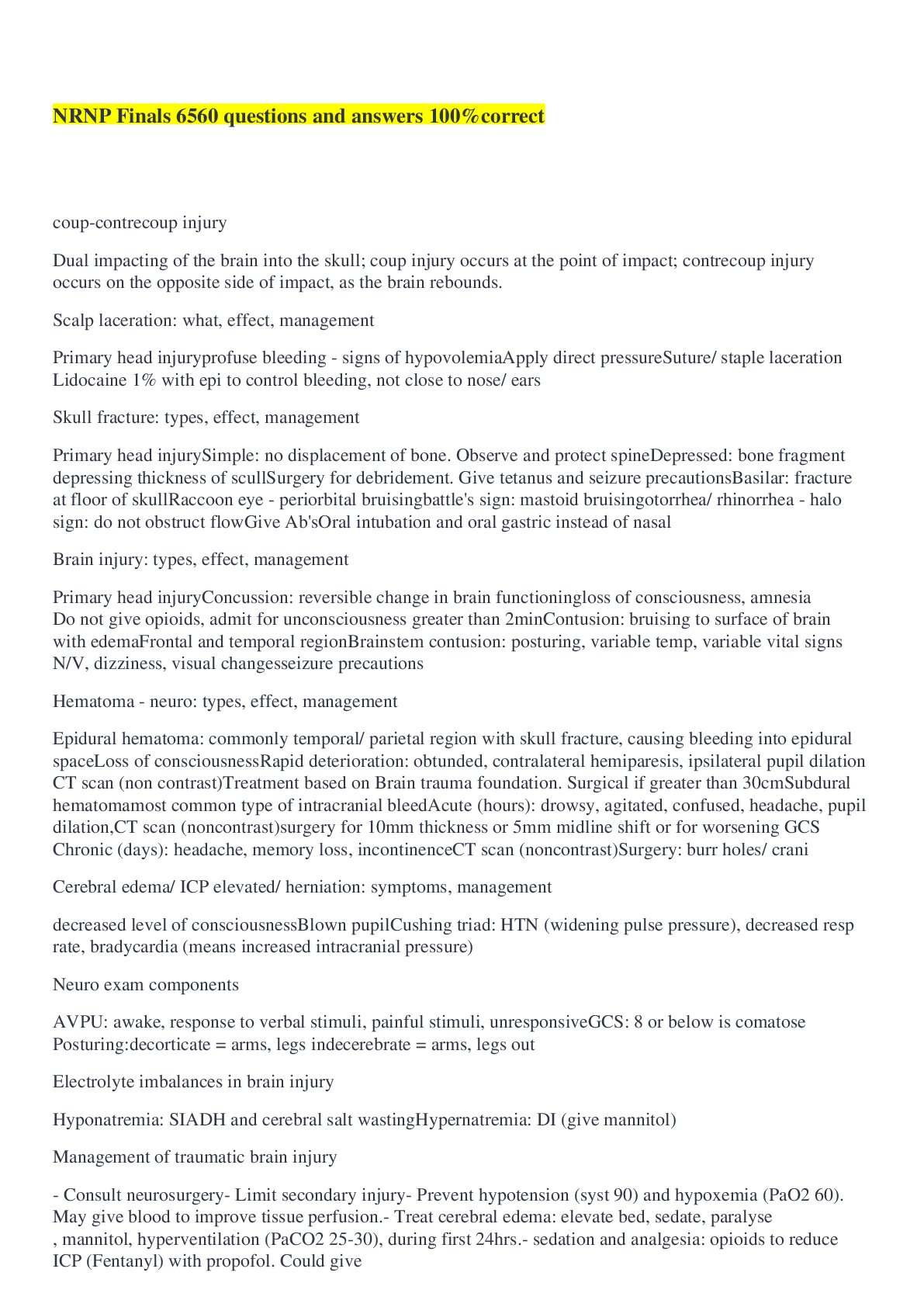
Buy this document to get the full access instantly
Instant Download Access after purchase
Buy NowInstant download
We Accept:

Also available in bundle (1)
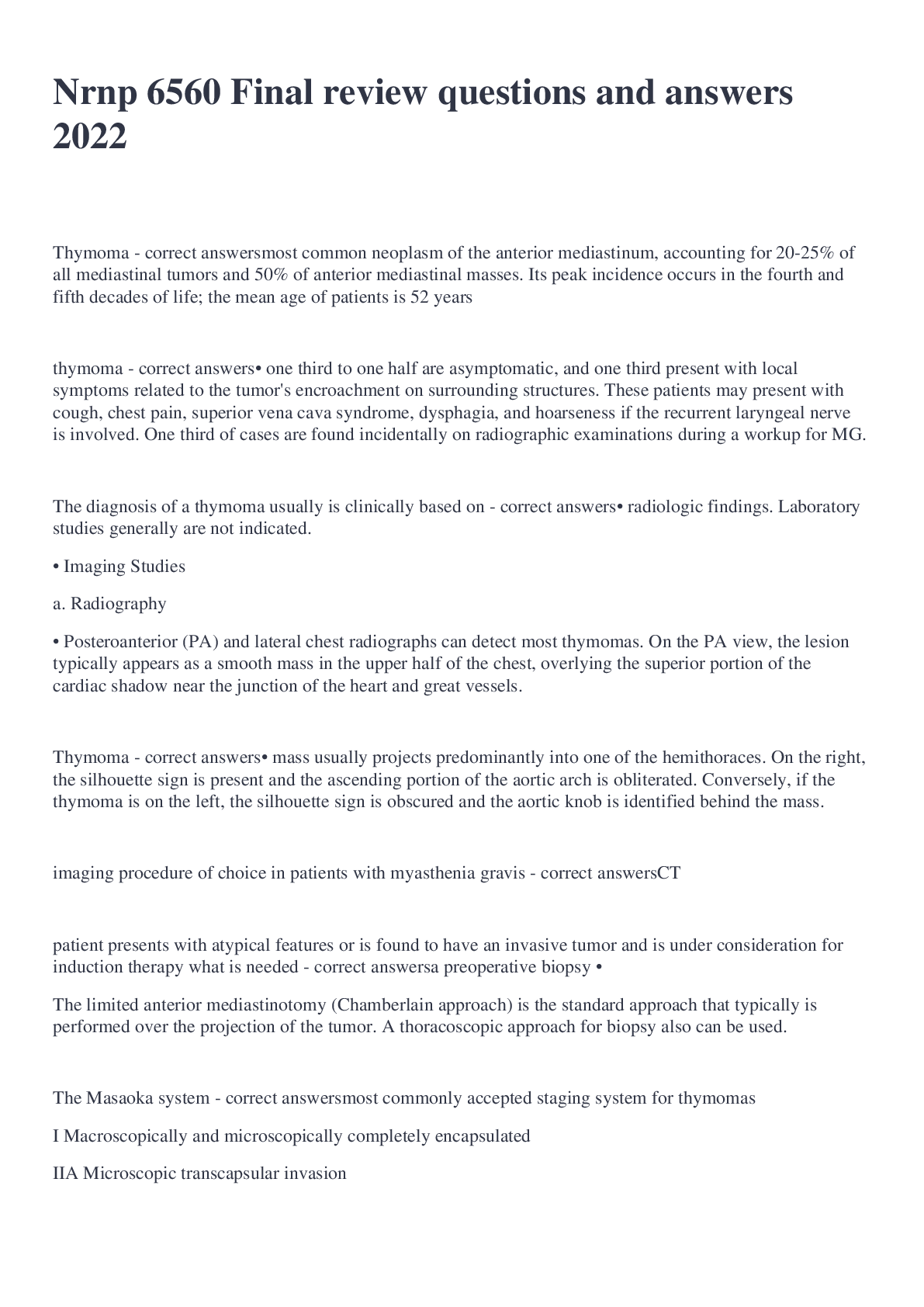
Bundles of Nrnp 6560 verified 2022/2023
Bundles of Nrnp 6560 verified 2022/2023
By FOREVERGREATIFUL2012 2 years ago
$15.5
2
Reviews( 0 )
$15.00
Can't find what you want? Try our AI powered Search
Document information
Connected school, study & course
About the document
Uploaded On
Nov 17, 2022
Number of pages
27
Written in
Additional information
This document has been written for:
Uploaded
Nov 17, 2022
Downloads
0
Views
63

